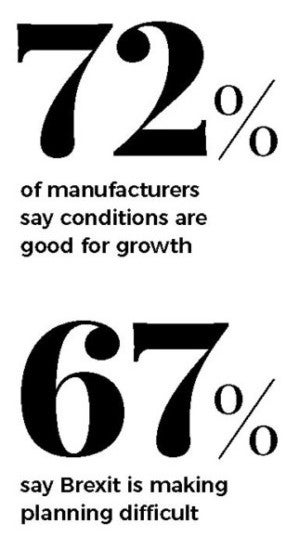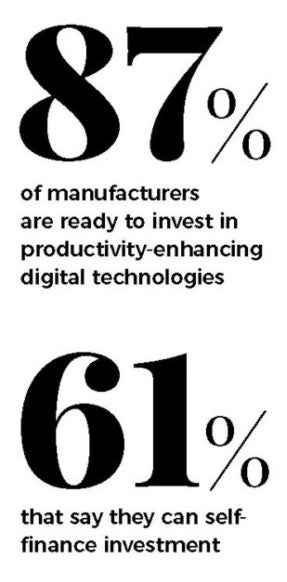To grow their business, in which technologies should manufacturers invest? How will this investment ensure their success?
Web presence. An example of this is a customer portal, which provides real-time, accurate data to the client. Improving communication improves satisfaction.
Darren Crisp, Group ERP Manager, Sofa Brands International
The internet of things and the connected cloud would be on the top of my list. Some 85 per cent of production assets are still unconnected according to AT Kearney and the World Economic Forum. It is also predicted that 80 billion IoT devices will be enabled by 2025. There is a huge potential for improvements in efficiency and visibility by getting more real-time information from production to planning. Artificial intelligence goes hand-in-hand with the above, almost like a “1a”. As the volumes of data coming from connected devices explodes, AI will make it easier for organisations to automate repetitive or mundane processes and help them focus their efforts on high-value and strategic tasks.
 Chandru Shankar, Industry director and EMEA business solutions lead for the manufacturing and resources sector, Microsoft
Chandru Shankar, Industry director and EMEA business solutions lead for the manufacturing and resources sector, Microsoft
They should invest in the technology that answers the problem they are currently trying to answer; there can be no one-size-fits-all-answer. The key is that any technology should solve a problem in the simplest, easiest-to-operate way, so that their people can get on with adding value to the organisation as effectively as possible.
Ben Salder, Change management and organisational development consultant
It’s all about increasing visibility and reducing manual processes – any investment towards these areas will contribute to success. Wireless data collection is a great example; it allows employees to continue on their day-to-day, collecting valuable data in real time, as they go.
From this you can easily determine where to improve overall supply chain productivity.
Emma Holland, Regional IT Manager EMEA & Asia Pacific, Progress Rail, A Catapillar Company
What does digital transformation look like in the manufacturing industry?
It looks like it does at home – our digital information connects seamlessly, making our lives easier. In the manufacturing environment, this means having a “single source of truth” that everyone uses and updates. As it does at home, technology in manufacturing should allow information to be accessed and shared quickly and with ease; it should allow us to make more effective decisions, more quickly than ever before. It should also enable us all to add value to the organisation more effectively than ever before.
Ben Salder
 Digital transformation in manufacturing is simply embracing technology. It’s taking the paper drawings from the shop floor and designing/showing them on mobile devices. It’s using robotics to reduce the number of manual processes in production, saving time and cutting costs. It’s ensuring that data can be reported in real time and be visible to everyone who needs it, improving product development and servitising solutions.
Digital transformation in manufacturing is simply embracing technology. It’s taking the paper drawings from the shop floor and designing/showing them on mobile devices. It’s using robotics to reduce the number of manual processes in production, saving time and cutting costs. It’s ensuring that data can be reported in real time and be visible to everyone who needs it, improving product development and servitising solutions.
Emma Holland
Digital transformation in manufacturing is all about capturing more accurate data, then analysing and using that data to inform decisions and developments. Do not be scared of technology; it is an essential part of any modern business. If there is part of your business where in the past technology may have been seen as a risk, it should now be seen as an enabler.
Darren Crisp
Digital transformation can enhance organisational performance in many areas. It means re-envisioning how organisations engage with their customers, optimise their operations, transform their products and empower their employees to do all of the above in a much better fashion.
Chandru Shankar
What advice would you give to a manufacturing company to help them grow?
Engage, equip and empower your employees – they’re your best asset.
Stuart Wood, Operations director, Applied Photophysics
Do what your customers want and need. Better still, tell them what they need and be that provider. The business model is now a relationship one. You can be niche or mass, but the key part is that you provide fantastic service and quality, consistently.
Neil Clarke, Head of business unit, Weetabix
Manufacturers need to have a strong focus on their core processes, which directly relate to customers’ needs and pain points. Flexibility in manufacturing is also key.
Gunther Boehner, Director, assembly, BMW Oxford
Growing the business needs to be led by the customer. You need to decide where your business best offers value over and above the competition. Think about what your customer really wants rather than what you’re currently offering.
Carl Haycock, UK printer operations director, Domino Printing Sciences
- Plan for post-Brexit protection.
- Invest now in your people and skills.
- Invest in research, development and infrastructure.
- Consider new global markets.
John Forkin, Managing Director, Marketing Derby
How are you transforming your business?
We are using live data in the manufacturing process to drive improvements in yield through automated test equipment. It removes subjective human assessment and poke-yokes the product [prevents errors] at each stage rather than fixing at the end of the process.
Carl Haycock
We are transforming our business by harnessing big data to act in a more predictive way – whether that is for maintenance practices, improved techniques or looking at how to improve the satisfaction
and motivation of our workforce.
Gunther Boehner
We need to focus on mastering the stability (and repeatability) that comes with lean manufacturing. You can’t just jump from the second manufacturing revolution to the fourth, and sadly very few UK manufacturers truly understand what this means. On the whole, I don’t believe that the UK is on top of transforming to true lean manufacturing. As an industry, we don’t have the foundations in place for lean manufacturing, everyone is still working with traditional procedures. There’s a lot of focus on tomorrow, rather than resolving these basics.
Stuart Wood
We are constantly growing our data visibility, through hardware and software. We are also using new machinery technologies to continually automate for consistency and lower costs. Live data gives real-time feedback to the operator on what they need to correct.
Neil Clarke
To grow their business, in which technologies should manufacturers invest? How will this investment ensure their success?

What does digital transformation look like in the manufacturing industry?

